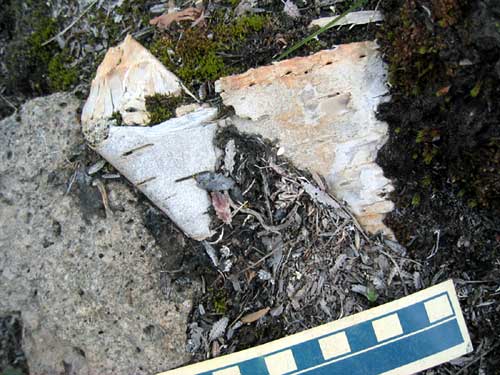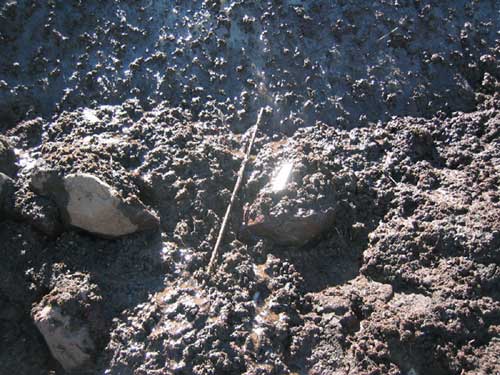 By Ned Rozell July 26, 2007
"When I pointed it out to Jim and Ruth Ann, they immediately saw that it was something special," said Manley, who works for the Institute of Arctic and Alpine Research at the University of Colorado at Boulder. Dixon and Warden noticed stitching holes in the bark fragment that lay among recently exposed rocks and moss. After later dating the birch-bark basket, they found an Alaskan had left it at the site about 650 years ago.  Photo by William Manley
In a five-year project in Wrangell-St. Elias National Park, researchers are following the lead of colleagues in the Yukon by traveling to high-country ice patches to search for old tools, clothing, and other organic materials exposed by retreating ice and snow. Dixon, an anthropology professor at the Institute of Arctic and Alpine Research at the University of Colorado at Boulder, has made several trips to the Wrangells during the project. "We can take a very small amount of organic material-like the amount you'd get from drilling a tooth-and do radio-carbon dating and isotope analysis," Dixon said. "We can find out the age of the material and environmental conditions at the time. We're getting new insights into the technology people used in Alaska thousands of years ago." Members of the team found several arrow shafts, dated at 370 to 850 years old, made of spruce wood split from the trunk of the tree rather than the branches. "The shafts are made from split staves of white spruce-long, straight slivers that are rounded and tapered," Dixon said. The Wrangells research team is concentrating on six ice patches in the largest national park in the United States. Dixon described the ice patches as "oasis-like features that attract caribou, sheep, and other animals that seek relief from heat and insects."  Photo by William Manley After a two-year GIS modeling project, the researchers chose the six ice patches they are studying after two years of flying around in late summer and looking for large bodies of ice and snow ringed with dark colors-often the pellets caribou dropped centuries ago. The ice patches are melting to reveal ground that hasn't seen the sun in hundreds, or thousands of years. "As climate change continues, (the exposure of artifacts from melting ice patches) will go on for some time," Dixon said. In addition to arrow shafts, a copper arrowhead, the birch basket, and an old caribou hide, the scientists and Park Service personnel also saw more modern things during their travels in the Wrangells, including the remains of a roadhouse built on a glacier on one of the gold rush routes from McCarthy to Chisana. "It's a whole roadhouse that's flowing down the glacier," Dixon said. Manley, the geologist who found the birch-bark basket, said looking for artifacts on the edge of ice patches is not only interesting science, it's great fun. The scientists usually have only a short window of time to search the base of an ice patch while a helicopter waits for them. "Finding such a well-preserved
artifact melting out of a glacier is something like winning when
you're gambling," Manley said. "After going hours,
or days without finding another one, you develop an urge to find
more."
Publish A Letter in SitNews Read Letters/Opinions
|